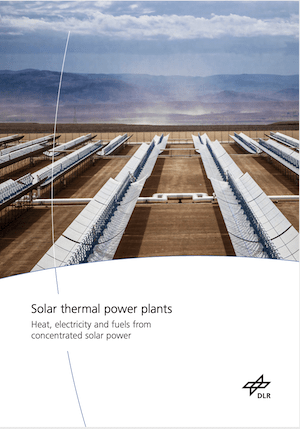How does a solar thermal power plant work?
How can solar thermal power plants contribute to security of supply?
What role do solar thermal power plants play in an energy system based on renewable energy sources?
What skills are required to build and operate solar thermal power plants?
Which factors support an accelerated proliferation of this technology?
How can technical innovations further reduce costs?
Answers to these questions and more in the new DLR study:
Solar thermal power plants: Heat, electricity and fuels from concentrated solar power
Concentrated solar power produces heat, electricity and fuel
- A DLR short study on solar thermal power plants summarises the current technological status, requirements and possibilities.
- Solar thermal power plants open the way for the production of controllable energy from renewable sources.
- The technology is about to be rolled out and has enormous potential.
- DLR has many years of experience and expertise in developing concentrating solar power systems.
- Focus: Energy, energy storage, solar thermal energy, hydrogen
In its short study; Solar thermal power plants: Heat, electricity and fuels from concentrated solar power the German Aerospace Center (Deutsches Zentrum für Luft- und Raumfahrt; DLR) gives an overview of the current situation, looking at the technological status, requirements and potential of Concentrating Solar Power (CSP) plants. The study focuses on the importance of these plants as a reliable supplier of controllable renewable heat and power for a sustainable future energy system. It answers frequently asked questions about how they work, geographical requirements, economic prospects and socio-economic consequences.
Power plant and storage system in one – for controllable energy from renewable sources
In a solar thermal power plant, mirrors collect sunlight and reflect it onto special receivers. The concentrated solar radiation heats a thermal transfer medium such as molten salt or a thermal oil to a temperature of up to 1000 degrees Celsius. This heat is either used immediately to generate electricity or stored in large tanks. Storage allows the power plant to obtain the heat to generate steam as required. The steam drives a turbine, which produces electricity via a generator. In this way, solar thermal power plants can supply electricity exactly when it is needed, regardless of the time of day or fluctuations in solar irradiance. At the same time, storing heat in large tanks of molten salt is 80 to 90 percent less expensive than storing electricity in batteries.
“These controllable power plants are enormously important for a stable energy supply. This is because renewable energy from wind power and photovoltaics is always subject to seasonal and diurnal fluctuations – in other words, it depends on whether the wind is blowing and the Sun is shining,” says Robert Pitz-Paal, Director of the DLR Institute of Solar Research, which coordinated the study. “In regions with the levels of direct solar radiation required, solar thermal power plants can replace fossil power plants as controllable power plants. In doing so, they open up the possibility of an energy system that relies predominantly or 100 percent on renewable sources of energy in these places.” In addition, solar thermal power plants can also provide process heat at a very high temperature for industrial companies and be used in the production of hydrogen and synthetic fuels. This helps to make industrial processes less carbon dioxide intensive and the mobility sector more sustainable.
Emerging technology with huge potential
Solar thermal power plants are still in their infancy. There are currently approximately 100 such plants worldwide, with a total capacity of 6.2 gigawatts. They are mainly located in the Sunbelt regions – around the Mediterranean and in North Africa, the southern USA and Australia, for example. Today, electricity from solar thermal power plants is already competitive with electricity from fossil fuels at favourable locations. “Innovation, mass production and greater competition within a growing market will contribute to a further significant reduction in costs,” says Pitz-Paal with certainty. He believes that electricity production costs of five US cents per kilowatt-hour will be achievable within the next 10 years.
The future of solar thermal power – with the latest technology and start-ups from Germany
German industry is well placed to position itself as a leader in this area of technology. Its focus on exports and extensive expertise in plant and mechanical engineering will prove particularly useful in this regard. “Further politically supported demonstration projects and reference plants will play a particularly important role in bringing innovations to market launch. At the same time, highly innovative small and medium-sized companies need support during the initial phase in order to be able to assert themselves in large power plant projects,” says Pitz-Paal. However, this development is not a one-way street. In order to achieve its long-term climate goals, Germany is dependent on energy imports. Sun-rich countries where solar thermal power plants produce controllable energy from renewable sources have the potential to become cooperation partners. This is also the case for the production of green hydrogen and synthetic fuels.
DLR as a partner for industry – over 40 years of expertise and experience
DLR has been developing concentrating solar power systems for solar thermal power plants for more than four decades. DLR is supporting the commercial launch of the technology, particularly in Spain, by analysing local conditions, developing solar collectors, conducting feasibility studies, implementing quality assurance measures and training specialised personnel. The fact that the solar fields of solar thermal power plants are now producing such high output around the world is thanks to technologies developed and marketed by DLR.
As part of the DLR’s energy research, approximately 200 scientists from seven DLR institutes are working on technologies for solar thermal power plants. In cooperation with industry partners, they are advancing and testing these new developments in order to further reduce the costs of electricity generated using solar thermal energy. In addition, several start-ups have emerged from DLR –
CSP Services, HelioHeat, Heliokon and Volateq – to become active in this field. Together, they now employ about 50 people.















































